Posted on 27 January 2018.
by Maria Porges
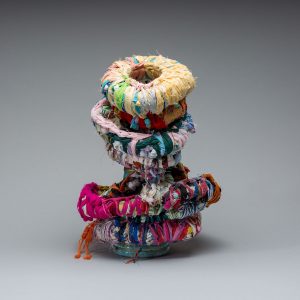
In Japan, the practice of mending broken ceramics by gluing them back together with a mixture of lacquer and gold dust dates back hundreds of years. The resulting objects, veined with gleaming seams, are highly valued, in part, for their added “imperfections.”
Regrettably, Western culture lacks such a tradition, defining successful restoration as the process of invisibly repairing damaged objects, returning them to their original appearance. That and an unrelenting glut of consumer goods — from dishes to clothes to furniture — has contributed to the near disappearance of even the most basic form of mending. Why fix something when we can throw it out and replace it?
In his recent body of work, Ramekon O’Arwisters explores the idea of mending as art practice: of restoration as a kind of reincarnation in a new and more exalted form. For several years, O’Arwisters has been leading “Crochet Jams,” events in which he leads students, seniors, art fair visitors and social service agency clients in a kind of collaborative craft therapy. By putting crochet hooks into their hands, O’Arwisters gets people to enjoy the process of shared labor, intertwining strips of colorful fabric in the same process that’s used to make rag rugs. A native of North Carolina, O’Arwisters was Introduced to quilt making at an early age by his beloved grandmother during his childhood in 1960s when Jim Crow laws were still in force. He remembers learning how to make something whole and beautiful out of many fragments of cloth. “With her,” the artist recalled, “I was embraced, important, and special. I was a little black boy hiding my queer self from my family … before the turbulent years of the Civil Rights Movement that spread throughout the country.” Both the generosity and spiritual healing of his current social practice and his drive to make something out of nothing grew out of those early experiences.
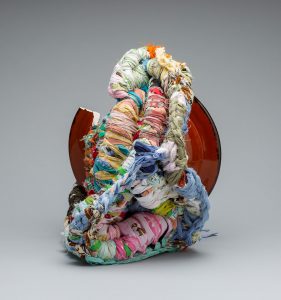
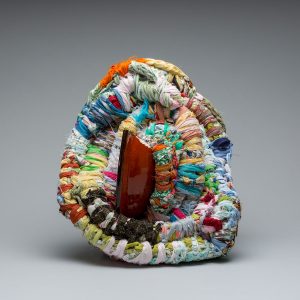
In the course of an artist’s residency at Recology (aka the San Francisco city dump) in late 2016, O’Arwisters began to consider how crocheting could transform broken ceramics he found there into something new. His experiments have resulted in a suite of fantastically strange and deeply beautiful objects. Presented on simple pedestals of unfinished wood, the freestanding sculptures in the show (along with two that are wall-mounted) incorporate one or more broken ceramic objects into a fabric form crocheted out of a wild variety of colors and textures. (O’Arwisters buys old clothes, linens and yard goods at thrift stores, and receives, as gifts, bags of these materials, all of which have resulted in a massive stockpile of fabric that is constantly being used and replenished.)
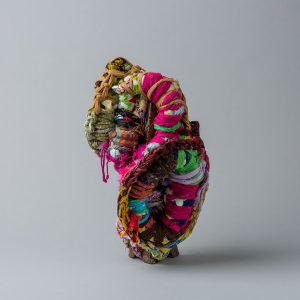
The shapes of many of the works on view are clearly meant to invoke vessels, but some are more abstract. In Mending 19, for instance, crocheted curves and circles envelop a tall, narrow vase, like vines overgrowing a neglected monument. In Mending 13, swags of material cradle a broken plate; peering into the small cavity at the top of the piece, gleaming threads suggest veins of gold in Japanese ceramics, or, perhaps, hidden treasure.
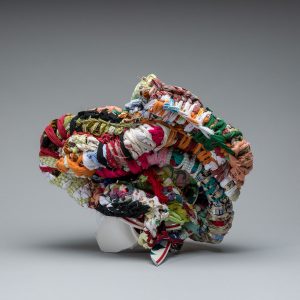
Mending 18, one of the least vessel-like pieces, is also one of the most compelling, indicative, perhaps, of possible directions the work might take. Jagged fragments of plate become a support for the sculpture’s intricately worked form. Wider than it is tall, it suggests a giant knot perched on dainty sharp feet. Other shards of ceramic protrude from the surface — as if the act of crocheting, like a geological process, had broken the vessel into the bits that now rise to its surface.
As much as this work seems singular, there are familial resemblances. Contemplating the loose threads and tassels of unraveled cloth that create a soft visual aura around some pieces, it’s impossible to ignore a sympathetic resonance with the thread sculpture of revered outsider artist Judith Scott. Michael Lucero’s sculptures, bricolaged together out of ceramic shards, form another branch of the family “tree”— works that are different, yet related, as are Julia Couzens’wrapped and sewn bundles of found textiles. In any case, it is difficult to describe the pleasure that contemplating O’Arwisters’ “mended” objects provide; photographs do them no justice. These are works of art that need to be seen in person, and looked at from all sides.
# # #
Ramekon O’Arwisters: “Mending” @ Patricia Sweetow through February 10, 2018.
About the Author:
Maria Porges is an artist and writer who lives and works in Oakland. For over two decades, her critical writing has appeared in many publications, including Artforum, Art in America, Sculpture, American Craft, Glass, the New York Times Book Review and many other publications. The author of more than 100 exhibition catalog essays, she presently serves as an associate professor at California College of the Arts.
